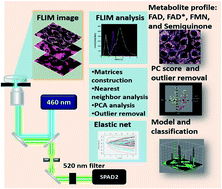A hybrid FLIM-elastic net platform for label free profiling of breast cancer†
Abstract
We report a label-free fluorescence lifetime profiling strategy to classify breast cancer cells, MCF10CA1h (malignant), MCF10A (nonmalignant), and MCF10AneoT (premalignant) in different stages of malignancy. Fluorescence Lifetime Imaging Microscopy (FLIM) was used to record the lifetime of autofluorescence of endogenous flavin in MCF10 cells in different stages of malignancy. Predominant differences in lifetimes ascertained by multi-exponential fitting curves can be attributed to the different forms of flavin protein; flavin mononucleotide (FMN), free flavin adenine dinucleotide (FAD), semiquinone, and bound FAD. A lifetime map of the metabolite was derived from the contribution of the lifetime of each metabolite by iterative reconvolution fitting of the Time Correlated Single Photon Counting (TCSPC) decay curves. Lifetime maps were constructed by mapping the average lifetime values pixel by pixel using MATLAB. The FLIM image (150 × 150 pixels) of each cell was extracted, resized and centered into 100 × 100 pixels using the nearest neighbor algorithm. Principal Component Analysis (PCA) in conjunction with Elastic net Analysis (EnA) was then used to classify the different stages of MCF10 cell lines based on average lifetime values. The EnA model provided an excellent classification of the cells at different stages of tumorigenesis yielding 100% accuracy.


 Please wait while we load your content...
Please wait while we load your content...